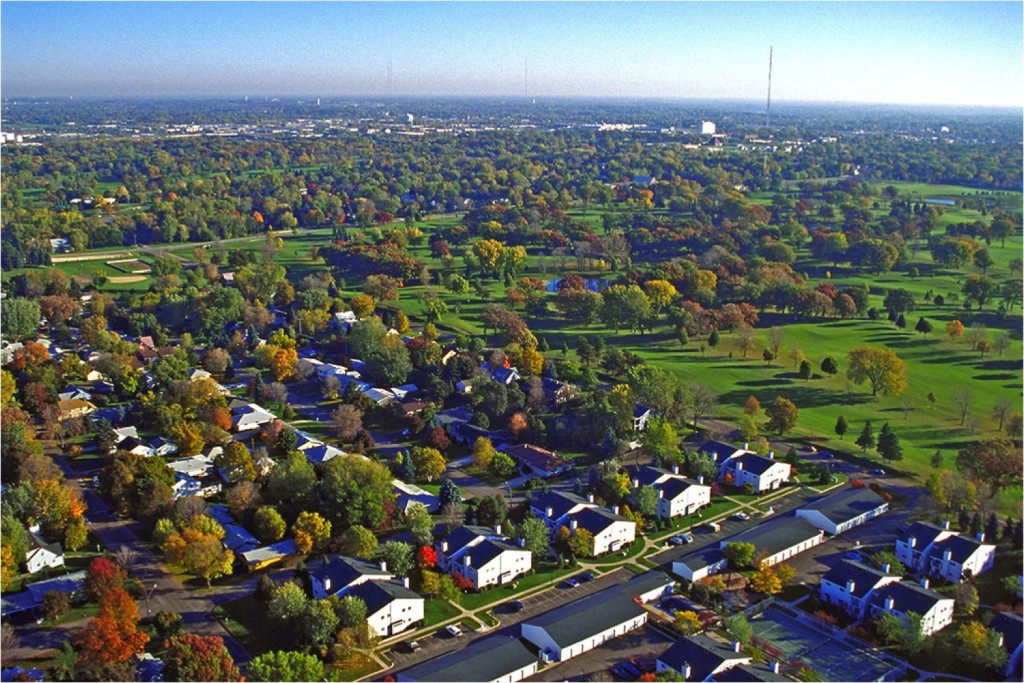2 July 2012
Scientists gauge carbon dioxide impact of suburban greenery
Posted by mcadams

View of the Minnesotan suburb where the scientists studied carbon dioxide uptake from various tree species and turfgrass. (Credit: The McFadden Lab, University of California, Santa Barbara.)
WASHINGTON – Despite having more carbon-dioxide-absorbing vegetation than cities, suburbs contribute to rising levels of carbon dioxide in the atmosphere. To find out how a suburb’s greenery influences its carbon dioxide emissions, two scientists have conducted continuous measurements of the uptake and release of carbon dioxide by the vegetation of a suburban landscape. They report that lawns and trees detectably reduce the carbon dioxide emissions of the area – in summer absorbing nearly all carbon dioxide released from fossil fuel use such as from traffic and natural gas consumption in homes.
By analyzing measurements taken across a 7 hectare (17.3-acre) plot of concentrated housing in a suburb outside of St. Paul, Minnesota, the researchers also showed how much of the absorption was due to different types of vegetation, including deciduous trees, evergreen trees, and turfgrass, the typical constituent of suburban lawns.
“This is important because given a certain amount of space, say a city park or homeowner’s yard, the carbon budget of that space depends on the amount of area covered by vegetation but also on the type of vegetation,” said Emily Peters, the paper’s lead author and post-doctoral associate of the Institute on the Environment at the University of Minnesota in St. Paul.
When evaluating such a ‘carbon budget,’ scientists weigh sources of carbon dioxide — for instance, burning of fossil fuels — against its ‘sinks,’ or whatever removes carbon dioxide from the space, such as plant photosynthesis. Their results, Peters said, likely apply to other areas with similar climate and plant species, such as suburbs in the mid-continental and northeastern United States.
Peters and McFadden will publish their findings on July 4 in the Journal of Geophysical Research-Biogeosciences, a journal of the American Geophysical Union.
Vegetation covers more than 80 percent of the suburb the scientists studied. When the researchers determined the net exchange of carbon dioxide between the study area and the atmosphere, they found that during May, June, and July, the landscape added no carbon dioxide to the atmosphere and sometimes even served as an overall sink of carbon dioxide.
Most surprising to both McFadden and Peters was how much turfgrass varied over the course of the year. Although turfgrass made up a smaller portion of the landscape the team studied than trees, it seemed to have a strong influence on the seasonal pattern of carbon uptake.
Past studies show that sometimes lawns absorb carbon dioxide and at others they release the gas. However, the scientists were not expecting how much this variation would influence the overall exchange of carbon dioxide between vegetation and the atmosphere. Overall, the scientists found that suburban lawns were most influential on carbon dioxide exchange in the spring and fall months, but strong carbon uptake by trees offset lawns’ summertime releases.
The fact that the vegetation offset fossil fuel emission for even part of the year was encouraging, Peters said, but the amount of the gas taken up was not enough to balance out the amount released by burning fossil fuels over the course of the year. “Unfortunately, far from it,” said McFadden, “We will still need to find ways to lower our carbon footprint.”
NASA Earth Science Division funded this study.
–Jessica Orwig, AGU Public Information Intern










 GeoSpace is a blog on Earth and space science, managed by AGU’s Public Information staff. The blog features posts by AGU writers and guest contributors on all sorts of relevant science topics, but with a focus on new research and geo and space sciences-related stories that are currently in the news.
GeoSpace is a blog on Earth and space science, managed by AGU’s Public Information staff. The blog features posts by AGU writers and guest contributors on all sorts of relevant science topics, but with a focus on new research and geo and space sciences-related stories that are currently in the news.